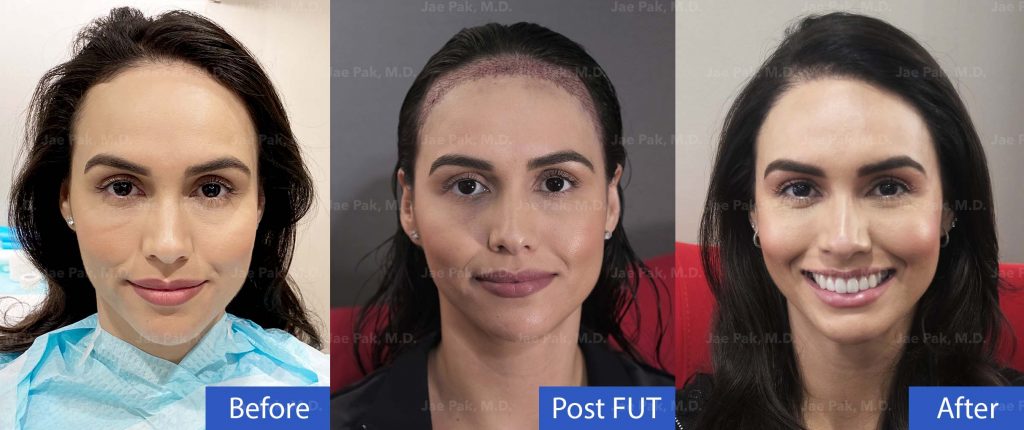Hairline Lowering Surgery: How To Prepare for Your Visit

With so many advances taking place in the world of hair restoration and cosmetic surgery, it can be hard to keep track of them all.
The wide array of modern treatments and procedures gives clients a lot of choices to achieve their unique aesthetic goals. You can use multiple methods to reach the same objective: a lower hairline and a smaller, more proportional forehead.
The category of hairline lowering procedures is exciting because it encompasses a few different techniques, draws from various practices in cosmetic surgery, and gives surgeons plenty of options when forming a personalized solution for clients.
But for the client undergoing hairline lowering surgery for the first time, there are plenty of questions that need answering. Despite being widespread and highly successful in most cases, this type of surgery is fairly new in medical history.
Let’s dive into the details of these procedures, find out what makes each method unique, and map out a plan so that you can prepare for each phase of the hairline lowering process from start to finish with Jae Pak MD.
What Is Hairline Lowering?

The term “hairline lowering” is a catch-all phrase that covers a lot of ground in the cosmetic surgery and hairline restoration fields.
We’ll start with a complete overview of the goals and methods of the surgery and discuss who may be good candidates before we talk about preparing for and undergoing a procedure from the patient’s perspective.
What Happens During Hairline Lowering Surgery?
While there are several ways to pursue hairline lowering with different tactics and technologies, the overall goal is the same for these types of surgeries: reduce the size of the forehead and create more proportional facial features for the client.
A large forehead is an aesthetic problem both men and women wish to address, whether a naturally high hairline, genetic pattern balding on the frontal scalp, or hair loss resulting from prior surgeries or medical events causes it.
Realistically, hairline lowering procedures can reduce the size of an individual’s forehead by up to 1.5 inches (nearly 4cm), although most cases do not necessitate so much movement of the hairline.
You may consider other secondary goals for these surgeries, including balancing an asymmetrical hairline, reshaping a jagged hairline from traction alopecia, or achieving any different number of aesthetic purposes.
Types of Procedures
Here are a few different terms and the various techniques used by cosmetic surgeons, hairline restoration experts, and others in the medical field.
Hairline Grafting
This term refers to a hair grafting technique that lowers the hairline via the transplantation from the back of the scalp to the frontal region.
Clinics will use this term to market hair transplant methods like FUT strip surgery or FUE to female clients who perceive these techniques to be more targeted toward men.

Transplantation can be an effective method for hairline lowering because the patient’s natural hair is used to create an organic, appealing hairline constructed precisely to their preferences.
These highly refined techniques have been popularized for over 20 years of great results for patients. But since the methods are so popular worldwide, patients will need to research heavily and ensure they’re not settling for less based on price or convenience.
Forehead Reduction
This method is a departure from the transplantation-based procedures we’ve just described.
Typically, forehead reduction surgery refers to the process of physically shortening the patient’s forehead skin after making an incision and loosening the scalp tissue.
While forehead reduction may be considered a more traditional form of plastic surgery than a hair restoration technique, there tends to be some crossover by specialists in both fields since a high degree of technical expertise and artistry is required.
The key advantages of forehead reduction surgery are precision, accuracy, permanence, and a relatively short recovery period with minimal scarring on the incision area.
We’re here to help
Schedule a consultation with Dr. Pak to learn more about Hairline Lowering Surgery.
Hairline Advancement
You may hear this term thrown around to mean either transplantation, forehead reduction (moving the scalp), or a combination of other procedures, including brow lifts or inserts.
“Foreheadplasty” is another vague term that doesn’t yet have a universal definition in the industry, so it’s essential to find out the exact methods used rather than going by the name alone.
Since we are still relatively early in developing these techniques, clients must realize that every clinic will do things slightly differently and swap out terms based on their own preferences and marketing strategies.
While one clinic may claim to be a hairline lowering expert, they might only perform traditional hair transplant techniques and do nothing with the physical advancement of the scalp skin itself.
When researching, always get as much information as possible, recognize that every clinic is unique, and avoid making assumptions to ensure you get the exact type of service you want.
Who Is a Good Candidate for Hairline Lowering Surgery?
Hairline lowering can be done in both men and women via both techniques described above. However, men are generally advised to avoid forehead reduction techniques since these require a strong, stable frontal hairline that may be disrupted by pattern balding and receding hairline.
Therefore, men are recommended to opt for traditional hair grafting surgery via FUT or FUE and work closely with a hair restoration professional to prevent further loss with medication and treatments.
Forehead reduction methods are almost always more effective for women since they run a lower risk of a receding hairline or the natural shape of the hairline changing over time.
The entire hairline can be moved forward by over 3cm and still maintain a natural, aesthetic look that won’t be undone by some minor thinning to the hair of the scalp.
Some factors may prevent patients from pursuing the hairline lowering plan they want, including various health conditions, hair loss from hormone imbalances, traumatic events causing hair loss, or other less common scenarios.
Getting Started: Choosing the Right Hairline Lowering Clinic
A successful hairline lowering procedure starts by selecting the best clinic for your needs. Follow these tips to make sure you are in good hands for your surgery from the very start.
Reputation and Reviews
As more clinics begin to offer hairline lowering services, many new offerings appear on search engines and aggregation sites for cosmetic procedures.
However, proceed with caution because only a handful of surgeons have been performing these surgeries for a considerable time, which is about ten or more years.
Spend plenty of time researching clinics, browsing before and after galleries, and ensuring your chosen clinic has the level of experience and expertise you can trust.
Choosing Your Best Options
Choose a clinic that offers both types of hairline lowering (grafting and forehead reduction), like Jae Pak MD, to be fully confident in your choice.
The best clinics will also give you a full breakdown of your medical options. This will cover factors like preserving hair, what natural supplements and health protocols to follow, alternative therapy suggestions, and the ongoing support you need to fully enjoy and protect your newly lowered hairline.
Preparing for Surgery and Recovery
Let’s discuss what you can expect as a patient as you begin this process and go through each step.
Consultation
After selecting your preferred clinic, your consultation will be the first order of business in strategizing the approach to hairline lowering.
During this one-on-one meeting, clients will discuss their personal experiences with their hair over the years, share their ideal aesthetic goals, and ask any questions and bring up concerns they may have.
Surgeons will take this time to recommend the best course of action depending on the client’s hair quality, hairline shape, skin type, donor hair supply, and several other factors.
Experience in Surgery
Little is required for clients to prepare for surgery beyond clearing their recovery schedule, at least ten days from work and physical activity. Like preparation for any surgery, patients should clean up their diets and eliminate the use of alcohol or tobacco at this time. The more healthy food and vitamins, the better!
Doctors may also ask that patients come off medications that may interfere with the body’s natural healing process, such as anti-inflammatories.
Proper Recovery
Recovering from hairline lowering will depend on the method used, but grafting and reduction techniques usually require several days of minimal movement and focused aftercare.
Patients should have plenty of food and water for their recovery experience, plus a comfortable setting in bed or on a couch where they can easily access necessities without much stress or strain.
Patients must follow recovery protocols during this time, including applying any medications or ointments to the area.
Bruising, swelling, and redness are expected in the first few days. Some forehead reduction procedures even lead to bruising around the eyes. These will all subside within a few days; then, steady recovery continues in the following months.
A New Era for Your Hairline Is Here
Hairline lowering is in the top tier of cosmetic procedures in terms of accessibility, effectiveness, and overall satisfaction for clients.
Whether you choose the transplantation-based method of hair grafting or the plastic-surgery-inspired forehead reduction, make sure to find a trusted clinic that puts your comfort first and delivers great results.
So what are you waiting for? Contact Jae Pak MD and schedule an appointment with us today!
Sources:
Hair Transplant to Lower Hairline | Psychreg
Find out if Hair Restoration is right for you.
Speak with Jae Pak, M.D. today!